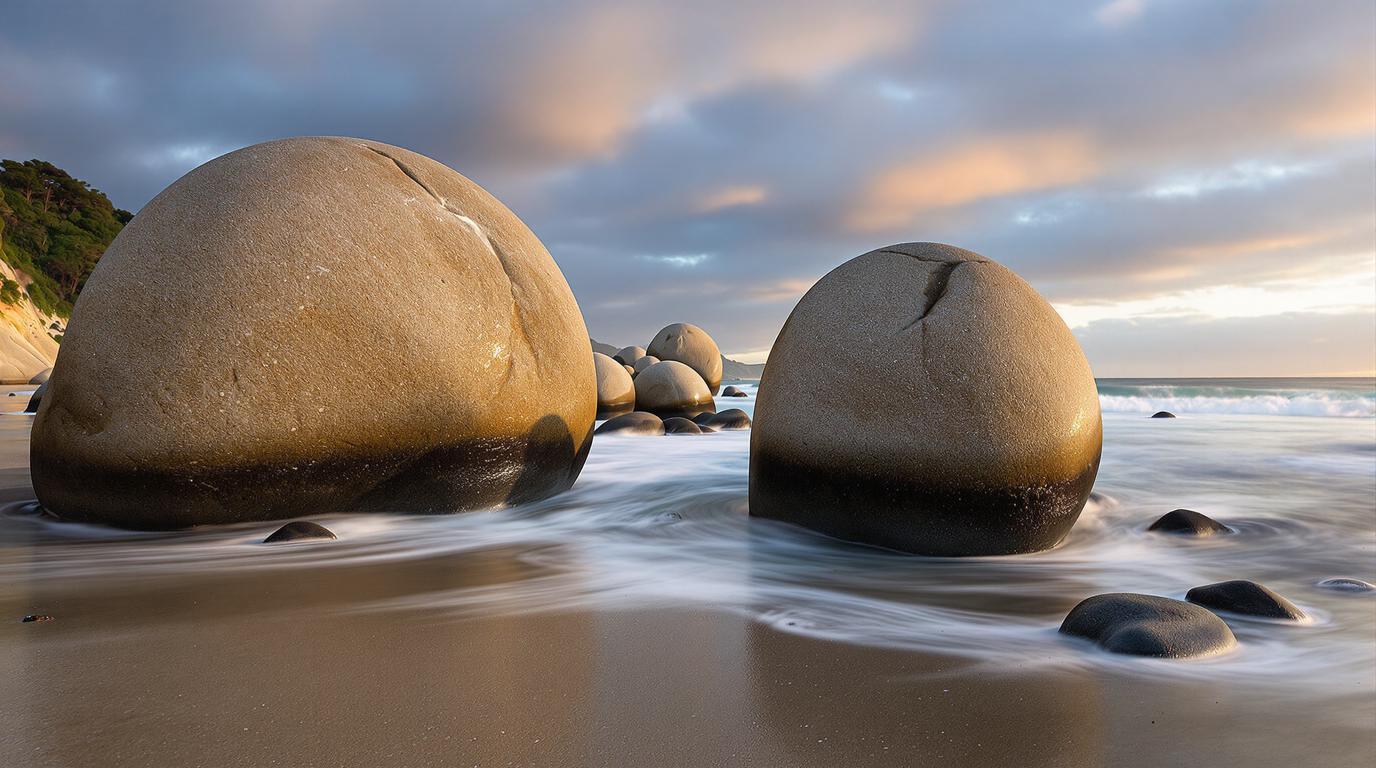The first time I glimpsed Moeraki’s scattered stone spheres from the clifftop path, I stopped mid-stride. Below me, perfectly round boulders—some larger than a man—dotted the beach like abandoned marbles from some giant’s game. The low tide had revealed dozens of them, their surfaces cracked into honeycomb patterns that gleamed with seawater under New Zealand’s southern sun. Nature’s geometry had never looked so deliberately artistic.
Where ancient legends meet geological wonder on New Zealand’s Otago coast
Long before scientists explained these boulders as 60-million-year-old concretions formed in ancient marine sediment, Māori tradition had already given them meaning. Local tribes know them as “Te Kaihinaki,” the food baskets washed ashore when the legendary canoe Āraiteuru wrecked offshore.
“Our ancestors saw these boulders as containers that once held kumara (sweet potatoes) and gourds,” explains Hinerangi, a Ngāi Tahu elder who often visits at sunrise. “The larger ones—we believe they were eel baskets. The science is fascinating, but our stories connect us to this place in a different way.”
These mysterious spheres emerge from coastal cliffs, where they’ve been embedded for millennia, before rolling onto Koekohe Beach—a process continuing today that makes visiting this remote coastal area different each time.
Discovering the secrets beyond the photographic hotspot
The hidden cove that tourists rarely find
While most visitors cluster around the main boulder field, a 15-minute walk north reveals something extraordinary. A small, unmarked path winds through coastal scrub to a secluded cove where the most perfectly spherical specimens rest in splendid isolation. Here, without the crowds, you can touch the cool, smooth surface of a half-submerged giant, feeling its prehistoric presence while waves lap quietly against the shore.
Local fisherman Dave Hutchins directed me here after our chance meeting at Fleur’s Place restaurant. “Everyone photographs the same boulders,” he told me. “But the real magic happens when you sit alone with these stones at dawn, watching them emerge from the sea mist.”
The cliff-top ecosystem overlooking ancient treasures
Climbing above the boulders, I discovered a windswept trail where yellow-eyed penguins occasionally nest. This unheralded path offers sweeping panoramas that contextualize the boulders within their dramatic coastal setting. In spring, wildflowers carpet the grassy slopes, creating a vibrant contrast to the dark spheres below.
Unlike ancient cities with spectacular architectural heritage, this natural phenomenon requires patience. Visit during low tide when the maximum number of boulders are visible, and prepare to be humbled by geological time.
Savoring coastal flavors in the shadow of ancient stones
Just ten minutes north in Moeraki village, Fleur’s Place stands on old wharf pilings, its weathered timber exterior belying culinary excellence within. Here, blue cod arrives so fresh it practically leaps from ocean to plate, simply prepared with lemon, herbs, and New Zealand olive oil.
Chef-owner Fleur Sullivan sources everything locally, including sea herbs foraged from shoreline rocks. “The boulders have watched over this coast for millions of years,” she tells me, placing a bowl of green-lipped mussels before me. “I just try to honor what’s been here all along.”
Planning your pilgrimage to these geological marvels
Timing your visit for maximum wonder
Arrive one hour before low tide to witness the full display of boulders. Early morning light (6-8 AM in summer) casts dramatic shadows across their textured surfaces, creating the photographic conditions that made these formations famous on social media. Check local tide charts before planning your visit.
Getting there and staying nearby
The boulders lie one hour north of Dunedin along coastal Highway 1. While many tourists make this a quick stop, consider booking at Moeraki Village Holiday Park for sunrise and sunset visits without crowds. Unlike other affordable exotic destinations, accommodations here remain reasonably priced even in peak season (December-February).
Reflecting on time’s patient artistry
As afternoon light softened the landscape, I watched waves reclaim the smaller boulders. Tomorrow they would emerge again, just as they have for countless millennia. In a world obsessed with immediacy, these spheres offer a humbling reminder of nature’s unhurried perfection. Some wonders simply cannot be rushed—neither in their formation nor in their appreciation.
